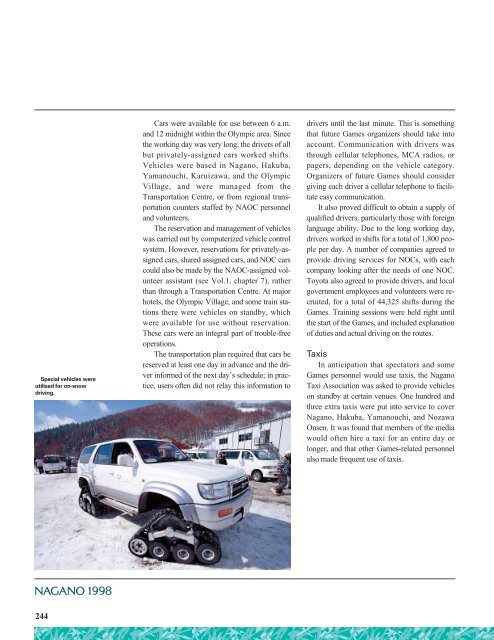107th IOC Session - LA84 Foundation
107th IOC Session - LA84 Foundation
107th IOC Session - LA84 Foundation
Create successful ePaper yourself
Turn your PDF publications into a flip-book with our unique Google optimized e-Paper software.
Special vehicles were<br />
utilised for on-snow<br />
driving.<br />
244<br />
Cars were available for use between 6 a.m.<br />
and 12 midnight within the Olympic area. Since<br />
the working day was very long, the drivers of all<br />
but privately-assigned cars worked shifts.<br />
Vehicles were based in Nagano, Hakuba,<br />
Yamanouchi, Karuizawa, and the Olympic<br />
Village, and were managed from the<br />
Transportation Centre, or from regional transportation<br />
counters staffed by NAOC personnel<br />
and volunteers.<br />
The reservation and management of vehicles<br />
was carried out by computerized vehicle control<br />
system. However, reservations for privately-assigned<br />
cars, shared assigned cars, and NOC cars<br />
could also be made by the NAOC-assigned volunteer<br />
assistant (see Vol.1, chapter 7), rather<br />
than through a Transportation Centre. At major<br />
hotels, the Olympic Village, and some train stations<br />
there were vehicles on standby, which<br />
were available for use without reservation.<br />
These cars were an integral part of trouble-free<br />
operations.<br />
The transportation plan required that cars be<br />
reserved at least one day in advance and the driver<br />
informed of the next day’s schedule; in practice,<br />
users often did not relay this information to<br />
drivers until the last minute. This is something<br />
that future Games organizers should take into<br />
account. Communication with drivers was<br />
through cellular telephones, MCA radios, or<br />
pagers, depending on the vehicle category.<br />
Organizers of future Games should consider<br />
giving each driver a cellular telephone to facilitate<br />
easy communication.<br />
It also proved difficult to obtain a supply of<br />
qualified drivers, particularly those with foreign<br />
language ability. Due to the long working day,<br />
drivers worked in shifts for a total of 1,800 people<br />
per day. A number of companies agreed to<br />
provide driving services for NOCs, with each<br />
company looking after the needs of one NOC.<br />
Toyota also agreed to provide drivers, and local<br />
government employees and volunteers were recruited,<br />
for a total of 44,325 shifts during the<br />
Games. Training sessions were held right until<br />
the start of the Games, and included explanation<br />
of duties and actual driving on the routes.<br />
Taxis<br />
In anticipation that spectators and some<br />
Games personnel would use taxis, the Nagano<br />
Taxi Association was asked to provide vehicles<br />
on standby at certain venues. One hundred and<br />
three extra taxis were put into service to cover<br />
Nagano, Hakuba, Yamanouchi, and Nozawa<br />
Onsen. It was found that members of the media<br />
would often hire a taxi for an entire day or<br />
longer, and that other Games-related personnel<br />
also made frequent use of taxis.
















